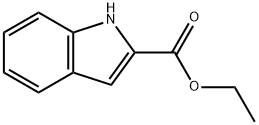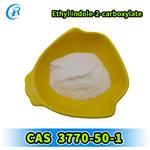Chemical Properties
white to yellow crystals or crystalline powder
Uses
2-Ethoxycarbonylindole is a building block that has been used as a reactant for the preparation of pyridazinoindole derivatives that have antimicrobial activities.
Uses
Reactant for preparation of:CRTH2 receptor antagonists;Indoleamine 2,3-dioxygenase (IDO) inhibitors;Cannabinoid CB1 receptor antagonists; Inhibitors of Human Reticulocyte 15-Lipoxygenase-1;N-(benzoylphenyl)-1H-indole-2-carboxamides as potent antihypertriglyceridemic agents;A antiproliferative agent against human leukemia K562 cells;Inhibitors of p38 MAP kinase; Acetolactate synthase inhibitors.
Preparation
Indole-2-carb-oxy-lic acid (0.50 g, 3.1 mmol) was dissolved in SOCl2 (19 ml) at 0°C. After stirring for 1 h, the solution was rotary evaporated, and the resulting oil was added to absolute ethanol (17 ml) at room temperature. After stirring overnight, the solution was vacuum filtered to yield ethyl 1H-indole-2-carboxyl-ate as a beige solid, which was recrystallized from methanol to yield 0.54 g (2.9 mmol, 93%) of the product[1].
References
[1] Will E. Lynch , Clifford W. Padgett, Christine R. Whitlock . “Ethyl 1H-indole-2-carboxyl-ate.” IUCrData 5 (2020): Article x201205.
Synthesis Reference(s)
Chemical and Pharmaceutical Bulletin, 39, p. 1152, 1991
DOI: 10.1248/cpb.39.1152
structure and hydrogen bonding
Lynch et al. report the crystal structure of ethyl 1H-indole-2-carboxyl-ate, which forms a hydrogen-bonded dimer. The hydrogen bonding occurs between N atoms of the indole ring and the keto oxygen atoms with an R(10) synthon. The hydrogen bond between N1 and O2i is characterized by an N…O separation of 2.877 Å;, and the ring motifs are placed on inversion centres in the space group P21/c. The crystal structure exhibits a classic herringbone pattern, with the blocks of hydrogen-bonded dimers and the zigzag running along the b-axis direction. The mol-ecule is nearly planar, with a r.m.s.d. of 0.028 Å for the non-hydrogen atoms. No other short contacts or π–π inter-actions are observed in the crystal[1].




